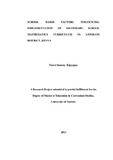| dc.description.abstract | This study investigated the school based factors influencing implementation of secondary school mathematics in Londiani district, Kericho County. This study was guided by four objectives; to determine the extent to which teaching methods influence the implementation of secondary schools Mathematics curriculum, analyze the extent which availability of textbooks influence the implementation of secondary school curriculum, to determine the extent to which teacher motivation influence the implementation of secondary school mathematics curriculum and to establish the extent to which mathematics language influences the implementation of secondary school mathematics curriculum. The Descriptive survey research design was used and data collected using questionnaires and an interview guide. The population consisted of 22 public secondary schools. The sample used in this study comprised of 22 principals, 314 students and 60 mathematics teachers making a total of 396 respondents. Data analysis was based on research questions and responses in questionnaires were tabulated, coded and processed and analyzed using Microsoft Excel program and presented in tables, graphs and pie-charts. The responses in open-ended items and interview were reported by descriptive narrative. The findings indicated that all schools principals had administrative training to carryout their administrative roles effectively.
The student: textbook ratio was found to vary between 2:1 up to 5:1 with an average of 3 students per book. In addition, large class size was found to influence mathematics curriculum implementation where the average teacher: student ratio for Londiani was found to be one mathematic teacher to 93 students. This indicated the schools suffered from shortage of mathematics teachers. There was also a wide variation in the head teacher perceptions regarding the meaning of mathematics curriculum implementation but majority of them thought the mathematics syllabus was being taught in their school at the right depth and width including the quality of coverage. Most schools also had effective or sufficient instructional supervision both from the principals and district school inspectors. School based actors such as teaching methods, resources; low teacher and student motivation, technical language used in mathematics were found to be key in explaining the unsatisfactory of the mathematics curriculum.
Teachers methodology dealing with mathematics curriculum implementation, availability of text books in relation to curriculum implementation teachers and learners motivation and technical language used in mathematics were found to negatively influence mathematics curriculum implementation in Londiani District. In view of this findings, the researcher recommended the introduction of students’ friendly methods of instruction such as group discussion, mastery learning, experimental method, project method and mathematical games should be highly encouraged. There should be special mathematic days where all mathematics teachers and learners participate for collaboration purposes. | en |

